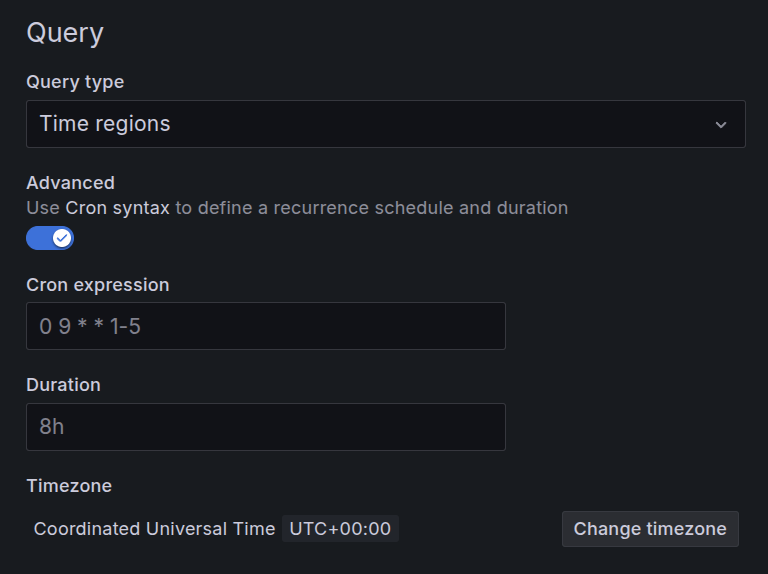What's new from Grafana Labs
Grafana Labs products, projects, and features can go through multiple release stages before becoming generally available. These stages in the release life cycle can present varying degrees of stability and support. For more information, refer to release life cycle for Grafana Labs.
Loading...
Area of interest:
Cloud availability:
Cloud editions:
Self-managed availability:
Self-managed editions:
No results found. Please adjust your filters or search criteria.
There was an error with your request.
Using Cron syntax, you can define more granular schedules than previously possible with just weekday and time selections. For example, it is now possible to create a single time region query that marks periods like “At 21:00 on the second Tuesday of every other month” or “Weekdays 9-5.” To try it out create an Annotation, toggle the Advanced switch and use Cron syntax to set more granular time region controls.

In previous releases, we added support for dashboard variables to a small number of transformations. Now this functionality has been added to all transformations, where applicable. All text input fields in transformations accept variable syntax:

You can now configure data links to be accessed with a single click. We’ve added the One click switch to data links for the following visualizations:
Grafana Fleet Management now includes the Grafana Cloud Integrations catalog, combining the preconfigured functionality of Integrations and the scalability of remote configuration.
Choose from a list of platform-specific integration templates to automatically build configuration pipelines in Fleet Management and then assign attributes to match those pipelines to specific collectors.
You can now provision your Grafana Fleet Management collectors and configuration pipelines using the Grafana Terraform provider (v3.19.0 or later).
Use Terraform to preregister new collectors for the Fleet Management service, add remote attributes to collectors that are already registered, and build configuration pipelines to remotely configure your fleet. With Terraform and Fleet Management, you can create a stable, consistent, scalable observability setup.
Last year we introduced one-click data links and actions for canvas visualizations in public preview and experimentally respectively. With the One click switch toggled on, it takes just a single click to open a data link or trigger an action. Now, both of these features are generally available for the canvas visualization.
Out-of-the-box, built-in alerts help you spend less time troubleshooting and more time focusing on what matters.
- Prevent slowdowns: Get alerts for high CPU usage in AWS EC2, Azure VMs, and GCP Compute Engine.
- Keep databases running smoothly: Avoid failures with alerts for deadlocks, failed connections, and disk space limits.
- Optimize storage and messaging: Stay ahead of storage constraints and ensure messages are delivered on time.

Whether you’re running on AWS, Azure, or GCP, you can fix issues faster because of real-time notifications, including:
We’ve fully deprecated API keys in Grafana, and all existing API keys have been automatically migrated to Service Accounts. No action is needed on your part—your API integrations will continue to work seamlessly while benefiting from improved security and management features.
We’re excited to unveil our latest update to the Generative AI Observability Cloud integration.
AI Observability is a Grafana Cloud integration we released late last year, designed to provide insights into gen AI application performance.
By leveraging OpenLIT, the OpenTelemetry-native, open-source SDK, it simplifies the monitoring, diagnosis, and optimization of generative AI systems. This integration automatically instruments over 50 gen AI tools, including LLMs, vector databases (vector DBs), and frameworks like LangChain and LlamaIndex, streamlining your setup process.
Our integration not only guides you through the setup but also offers pre-built dashboards that can be customized to fit your needs. These dashboards, focused on LLM & VectorDB Observability, now include an exciting new feature: OpenTelemetry-based GPU monitoring! This new capability enables you to track GPU performance through key metrics such as utilization percentage, temperature, power consumption, and more, allowing you to optimize the efficiency of your AI workloads.
View how persistent volume (PV) changes over a specific time range in the storage tab on the Cluster, Namespace, Workload, Node, and Pod detail pages.

Grafana Service Center is now in public preview. The Service Center provides users a single pane of glass into key operational resources, including SLOs, Incidents, and Dashboards with more resources coming soon.
All Grafana SLO dashboards are now natively integrated with a Grafana SIFT panel. SIFT automatically checks burning SLOs for common issues and reports back using the SIFT panel in all auto-generated SLO dashboards. You can also manually run SIFT checks from the Grafana SLO dashboard.
One of the basic goals of performance testing is to ensure your applications perform well under various levels of traffic. However, most performance tests are conducted with minimal insight into why a system performs a certain way during testing.



